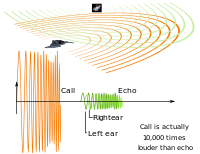Eĥolokigo

Eĥolokigo, nomita ankaŭ biosonaro, estas la biologia sonaro uzita de kelkaj tipoj animaloj. Eĥolokigaj animaloj elsendas alvokojn el la medio kaj aŭskultas la eĥojn de tiuj alvokoj kiuj revenas el variaj objektoj apud ili. Ili uzas tiujn eĥojn por lokigi kaj identigi la objektojn. Eĥolokigo estas uzata por navigado kaj por manĝado (aŭ ĉasado) en variaj medioj.
Eĥolokigaj animaloj estas kelkaj mamuloj kaj malmultaj birdoj; ĉefe mikrokiropteraj vespertoj kaj odontocetoj (dentobalenoj kaj delfenoj), sed ankaŭ en pli simpla formo en aliaj grupoj kiaj sorikoj, unu genro de megakiropteraj vespertoj (Rousettus) kaj du kavernoloĝantaj birdogrupoj, nome la tiel nomitaj apusetoj de la genro Aerodramus (iam nomita Collocalia) kaj la nerilata Oleobirdo, Steatornis caripensis.[1]
Vidu ankaŭ[redakti | redakti fonton]
Notoj[redakti | redakti fonton]
- ↑ Holland, R. A.; Waters, D. A.; Rayner, J. M. V. (2004). "Echolocation signal structure in the Megachiropteran bat Rousettus aegyptiacus Geoffroy 1810". Journal of Experimental Biology. 207 (25): 4361–4369. doi:10.1242/Jeb.01288. PMID 15557022.
Bibliografio[redakti | redakti fonton]
- Anderson, J.A. (1995) An Introduction to Neural Networks. MIT Press.
- Au, W.W.L. (1993). The Sonar of Dolphins. New York: Springer-Verlag. Provides a variety of findings on signal strength, directionality, discrimination, biology and more.
- Pack, A.A.; Herman, L.M. (1995). "Sensory integration in the bottlenosed dolphin: Immediate recognition of complex shapes across the senses of echolocation and vision". Journal of the Acoustical Society of America. 98 (2): 722–733. Bibcode:1995ASAJ...98..722P. doi:10.1121/1.413566. PMID 7642811.
- Carew, T. (2001). Behavioral Neurobiology. Sinauer Associates, Inc., USA.
- Fenton, M.B. 1995. Natural History and Biosonar Signals. In: Hearing in Bats. Popper, A.N. and Fay, R.R. (eds.). Springer Verlag. New York. pp. 37–86.
- Grinnell, A.D. (1995). Hearing in Bats: An Overview. In: Hearing in Bats. Popper, A.N. and Fay, R.R. (eds.). Springer Verlag. New York. pp. 1–36.
- Hiryu, S.; et al. (2007). "Echo-intensity compensation in echolocating bats (Pipistrellus abramus) during flight measured by a telemetry microphone". J. Acoust. Soc. Am. 121 (3): 1749. Bibcode:2007ASAJ..121.1749H. doi:10.1121/1.2431337.
- Hopkins, C. (2007). Echolocation II. BioNB 424 Neuroethology Powerpoint presentation. Cornell University, Ithaca NY.
- Jones, G.; Teeling, E.C. (2006). "The evolution of echolocation in bats". Trends in Ecology and Evolution. 21 (3): 149–156. doi:10.1016/j.tree.2006.01.001.
- Ketten. D.R. (1992) The Marine Mammal Ear: Specializations for aquatic audition and echolocation. In: The Evolutionary Biology of Hearing, D. Webster, R. Fay, and A. Popper (eds.), Springer-Verlag, pp. 717–750.
- Ketten, D.R. (2000) Cetacean Ears. In: Hearing by Whales and Dolphins. W. Au, R. Fay, and A. Popper (eds.), SHAR Series for Auditory Research, Springer-Verlag, pp. 43–108.
- Moss, C.; Sinha, S. (2003). "Neurobiology of Echolocation in Bats". Current Opinion in Neurobiology. 13 (6): 751–758. doi:10.1016/j.conb.2003.10.016.
- Neuweiler, G (2003). "Evolutionary aspects of bat echolocation". J. Comp. Physiol. A. 189: 245–256.
- Pollak, G.; et al. (1977). "Echo-detecting characteristics of neurons in inferior colliculus of unanesthetized bats". Science. 196 (4290): 675–678. Bibcode:1977Sci...196..675P. doi:10.1126/science.857318.
- Reynolds J.E. III & Rommel S.A. (1999), Biology of Marine Mammals, Smithsonian Institution Press.
- Schnitzler, H.U.; Flieger, E. (1983). "Detection of oscillating target movements by echolocation in the Greater Horseshoe bat". J. Comp. Physiol. 153 (3): 385–391. doi:10.1007/bf00612592.
- Schuller, G.; Pollack, G. (1979). "Disproportionate frequency representation in the inferior colliculus of Doppler-compensating greater horseshoe bats: Evidence of an acoustic fovea". Journal of Comparative Physiology A. 132 (1): 47–54. doi:10.1007/bf00617731.
- Simmons, J.A.; Stein, R.A. (1980). "Acoustic Imaging in bat sonar: echolocation signals and the evolution of echolocation". J. Comp. Physiol. A. 135 (1): 61–84. doi:10.1007/bf00660182.*Speakman, J.; Racey, P. (April 1991). "No cost of echolocation for bats in flight". Nature. 350 (6317): 421–423. Bibcode:1991Natur.350..421S. doi:10.1038/350421a0. PMID 2011191.
- Suga, N.; Niwa, H.; Taniguchi, I.; Margoliash, D. (1987). "The personalized auditory cortex of the mustached bat: adaptation for echolocation". Journal of Neurophysiology. 58: 643–654.
- Suga, N.; O'Neill, W.E. (1979). "Neural axis representing target range in the auditory cortex of the mustache bat". Science. 206 (4416): 351–353. Bibcode:1979Sci...206..351S. doi:10.1126/science.482944.
- Suga, N; Simmons, J.A.; Jen, P.H. (1975). "Peripheral specialization for fine analysis of doppler-shifted echoes in the auditory system of the "CF-FM" bat Pteronotus parnellii". Journal of Experimental Biology. 63: 161–192.
- Wilson, W. & C. Moss (2004) in Echolocation in Bats and Dolphins, J. Thomas, C. Moss, eds. pp. 22-.
- Zupanc, G.K.H. 2004. Behavioral Neurobiology: An Integrative Approach. Oxford University Press: Oxford, UK.
